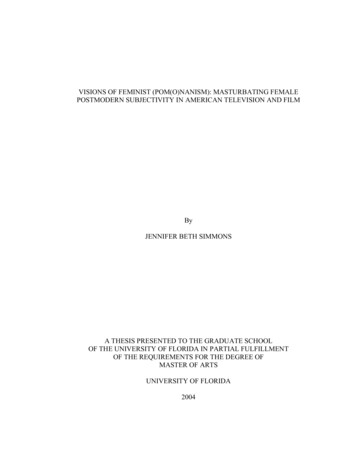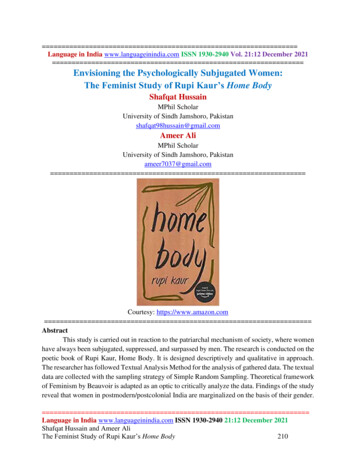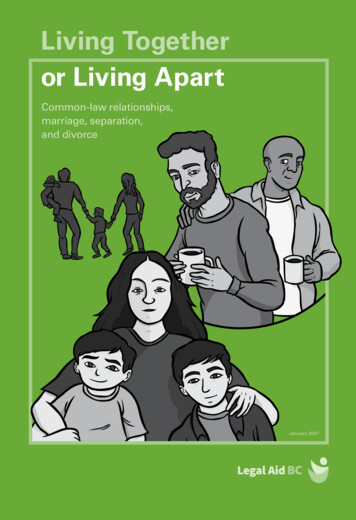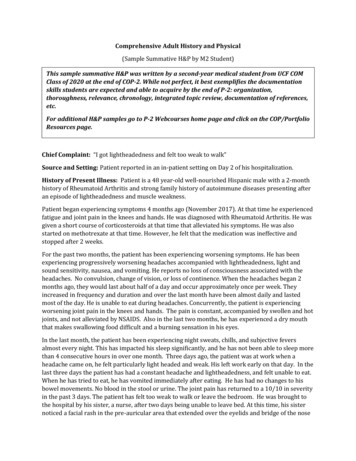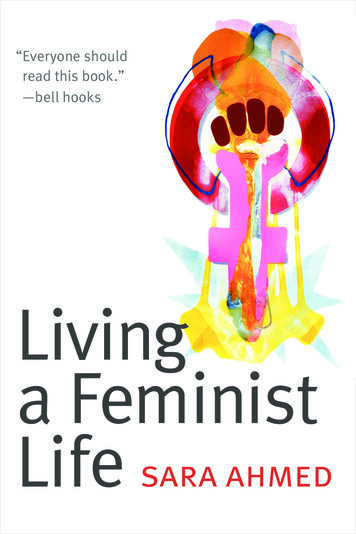
Transcription
“Everyone shouldread this book.”—bell hooksLivinga FeministLife Sara ahmed
Living aFeministLifeSARA AHMEDDuke University Press / Durham and London/2017
2017 Duke University PressAll rights reservedPrinted in the United States of America on acid-free paper Designed by Heather HensleyTypeset in Arno Pro by Graphic Composition, Inc., Bogart, GeorgiaLibrary of Congress Cataloging-in-Publication DataNames: Ahmed, Sara, [date] author.Title: Living a feminist life / Sara Ahmed.Description: Durham : Duke University Press, 2017.Includes bibliographical references and index.Identifiers:lccn 2016032264 (print)lccn 2016033775 (ebook)isbn 9780822363040 (hardcover : alk. paper)isbn 9780822363194 (pbk. : alk. paper)isbn 9780822373377 (e-book)Subjects: lcsh: Feminist theory. Feminism.Classification: lcc hq1190.a36 2017 (print) lcc hq1190 (ebook) ddc 305.4201—dc23lc record available at https: // lccn.loc.gov / 2016032264Cover Art: Carrie Moyer, Chromafesto (Sister Resister 1.2), 2003, acrylic, glitter on canvas,36 24 inches. Carrie Moyer. Courtesy of DC Moore Gallery, New York.
To the many feminist killjoysout there doing your thing:THIS ONE IS FOR YOU.
CONTENTSix1AcknowledgmentsIntroduction Bringing Feminist Theory Home19PART I21651. Feminism Is Sensational2. On Being Directed3. Willfulness and Feminist Subjectivity89PART II931354. Trying to Transform5. Being in Question6. Brick Walls161PART III1637. Fragile Connections8. Feminist Snap9. Lesbian Feminism43115187213235251269281291BECOMING FEMINISTDIVERSITY WORKLIVING THE CONSEQUENCESConclusion 1 A Killjoy Survival KitConclusion 2 A Killjoy ManifestoNotesReferencesIndex
ACKNOWLEDGMENTSThis is the first time I have written a book alongside a blog. Thank you somuch to those who encouraged me to start my blog, especially my feministfriends on Facebook. Thanks also to those with whom I have engaged onsocial media since. I have learned so much. Thanks to Mulka and Poppy foryour furry brown companionship, then and now. Thanks to Leona Lewis foryour voice and inspiration. My special thanks to my partner in feminist crime,Sarah Franklin. My appreciation to Duke University Press for working withme again, and to Ken Wissoker and Elizabeth Ault for sustaining your enthusiasm for this project throughout, as well as to Liz Smith for her patience atthe late stages. To my feminist colleagues at Goldsmiths and beyond, I appreciate the care and connection, whether from near or afar, especially RumanaBegum, Sirma Bilge, Lisa Blackman, Ulrika Dahl, Natalie Fenton, YasminGunaratnam, Heidi Mirza, Fiona Nicoll, Nirmal Puwar, Beverley Skeggs,Elaine Swan, and Isabel Waidner. To those who have participated in the Centrefor Feminist Research and the Feminist Postgraduate Forum, thanks for working to make work a better and safer place, especially Tiffany Page and LeilaWhitley. During the copyediting of this book, I made the difficult decision toresign from my post at Goldsmiths after three years of working with othersto challenge how sexual harassment has become normalized in academic culture. I have been overwhelmed by the feminist solidarity and support I havereceived. Each message brought a message home to me, one I have been tryingto write about in this book: living a feminist life is about how we connect withand draw upon each other in our shared project of dismantling worlds. We arechipping away, slowly, but we are chipping away!
INTRODUCTION Bringing Feminist Theory HomeWhat do you hear when you hear the word feminism? It is a word that fills mewith hope, with energy. It brings to mind loud acts of refusal and rebellion aswell as the quiet ways we might have of not holding on to things that diminishus. It brings to mind women who have stood up, spoken back, risked lives,homes, relationships in the struggle for more bearable worlds. It brings tomind books written, tattered and worn, books that gave words to something,a feeling, a sense of an injustice, books that, in giving us words, gave us thestrength to go on. Feminism: how we pick each other up. So much history ina word; so much it too has picked up.I write this book as a way of holding on to the promise of that word, tothink what it means to live your life by claiming that word as your own: being a feminist, becoming a feminist, speaking as a feminist. Living a feministlife does not mean adopting a set of ideals or norms of conduct, although itmight mean asking ethical questions about how to live better in an unjust andunequal world (in a not-feminist and antifeminist world); how to create relationships with others that are more equal; how to find ways to support thosewho are not supported or are less supported by social systems; how to keepcoming up against histories that have become concrete, histories that havebecome as solid as walls.It is worth noticing from the outset that the idea that feminism is abouthow to live, about a way of thinking how to live, has often been understood aspart of feminist history, as dated, associated with the moralizing or even polic-
ing stance of what might be called or might have been called, usually dismissively, cultural feminism. I will return to the politics of this dismissal in chapter 9. I am not suggesting here that this version of feminism as moral police,the kind of feminism that might proceed by declaring this or that practice(and thus this or that person) as being unfeminist or not feminist, is simply afabrication. I have heard that judgment; it has fallen on my own shoulders.1But the figure of the policing feminist is promiscuous for a reason. Feminism can be more easily dismissed when feminism is heard as about dismissal; as being about making people feel bad for their desires and investments. The figure of the feminist policer is exercised because she is useful;hearing feminists as police is a way of not hearing feminism. Many feministfigures are antifeminist tools, although we can always retool these figuresfor our own purposes. A retooling might take this form: if naming sexism isunderstood as policing behavior, then we will be feminist police. Note thatretooling antifeminist figures does not agree with the judgment (that to question sexism is to police) but rather disagrees with the premise by convertingit into a promise (if you think questioning sexism is policing, we are feministpolice).In making feminism a life question, we will be judged as judgmental. In thisbook I refuse to relegate the question of how to live a feminist life to history.To live a feminist life is to make everything into something that is questionable. The question of how to live a feminist life is alive as a question as well asbeing a life question.If we become feminists because of the inequality and injustice in the world,because of what the world is not, then what kind of world are we building?To build feminist dwellings, we need to dismantle what has already been assembled; we need to ask what it is we are against, what it is we are for, knowingfull well that this we is not a foundation but what we are working toward. Byworking out what we are for, we are working out that we, that hopeful signifierof a feminist collectivity. Where there is hope, there is difficulty. Feminist histories are histories of the difficulty of that we, a history of those who have hadto fight to be part of a feminist collective, or even had to fight against a feministcollective in order to take up a feminist cause. Hope is not at the expense ofstruggle but animates a struggle; hope gives us a sense that there is a point toworking things out, working things through. Hope does not only or alwayspoint toward the future, but carries us through when the terrain is difficult,when the path we follow makes it harder to proceed.2 Hope is behind us whenwe have to work for something to be possible.2/ Introduction
A FEMINIST MOVEMENTFeminism is a movement in many senses. We are moved to become feminists.Perhaps we are moved by something: a sense of injustice, that something iswrong, as I explore in chapter 1. A feminist movement is a collective politicalmovement. Many feminisms means many movements. A collective is whatdoes not stand still but creates and is created by movement. I think of feministaction as like ripples in water, a small wave, possibly created by agitation fromweather; here, there, each movement making another possible, another ripple,outward, reaching. Feminism: the dynamism of making connections. And yeta movement has to be built. To be part of a movement requires we find placesto gather, meeting places. A movement is also a shelter. We convene; we havea convention. A movement comes into existence to transform what is in existence. A movement needs to take place somewhere. A movement is not just oronly a movement; there is something that needs to be kept still, given a place,if we are moved to transform what is.We might say a movement is strong when we can witness a momentum:more people gathering on the streets, more people signing their names to protest against something, more people using a name to identify themselves. Ithink we have in recent years witnessed the buildup of a momentum aroundfeminism, in global protests against violence against women; in the increasing number of popular books on feminism; in the high visibility of feministactivism on social media; in how the word feminism can set the stage on firefor women artists and celebrities such as Beyoncé. And as a teacher, I havewitnessed this buildup firsthand: increasing numbers of students who wantto identify themselves as feminists, who are demanding that we teach morecourses on feminism; and the almost breathtaking popularity of events we organize on feminism, especially queer feminism and trans feminism. Feminismis bringing people into the room.Not all feminist movement is so easily detected. A feminist movement isnot always registered in public. A feminist movement might be happening themoment a woman snaps, that moment when she does not take it anymore (seechapter 8), the violence that saturates her world, a world. A feminist movement might happen in the growing connections between those who recognizesomething—power relations, gender violence, gender as violence—as beingwhat they are up against, even if they have different words for what that whatis. If we think of the second-wave feminist motto “the personal is political,” wecan think of feminism as happening in the very places that have historicallyBringing Feminist Theory Home / 3
been bracketed as not political: in domestic arrangements, at home, everyroom of the house can become a feminist room, in who does what where, aswell as on the street, in parliament, at the university. Feminism is whereverfeminism needs to be. Feminism needs to be everywhere.Feminism needs to be everywhere because feminism is not everywhere.Where is feminism? It is a good question. We can ask ourselves: where didwe find feminism, or where did feminism find us? I pose this question as a lifequestion in the first part of this book. A story always starts before it can betold. When did feminism become a word that not only spoke to you, but spokeyou, spoke of your existence, spoke you into existence? When did the soundof the word feminism become your sound? What did it mean, what does it do,to hold on to feminism, to fight under its name; to feel in its ups and downs, inits coming and goings, your ups and downs, your comings and goings?When I think of my feminist life in this book, I ask “from where?” but also“from whom?” From whom did I find feminism? I will always remember aconversation I had as a young woman in the late 1980s. It was a conversationwith my auntie Gulzar Bano. I think of her as one of my first feminist teachers.I had given her some of my poems. In one poem I had used he. “Why do youuse he,” she asked me gently, “when you could have used she?” The question,posed with such warmth and kindness, prompted much heartache, much sadness in the realization that the words as well as worlds I had thought of asopen to me were not open at all. He does not include she. The lesson becomesan instruction. To make an impression, I had to dislodge that he. To becomeshe is to become part of a feminist movement. A feminist becomes she evenif she has already been assigned she, when she hears in that word a refusal ofhe, a refusal that he would promise her inclusion. She takes up that word sheand makes it her own.I began to realize what I already knew: that patriarchal reasoning goes allthe way down, to the letter, to the bone. I had to find ways not to reproduce itsgrammar in what I said, in what I wrote; in what I did, in who I was. It is important that I learned this feminist lesson from my auntie in Lahore, Pakistan,a Muslim woman, a Muslim feminist, a brown feminist. It might be assumedthat feminism travels from West to East. It might be assumed that feminismis what the West gives to the East. That assumption is a traveling assumption,one that tells a feminist story in a certain way, a story that is much repeated;a history of how feminism acquired utility as an imperial gift. That is not mystory. We need to tell other feminist stories. Feminism traveled to me, growingup in the West, from the East. My Pakistani aunties taught me that my mind is4 /Introduction
my own (which is to say that my mind is not owned); they taught me to speakup for myself; to speak out against violence and injustice.Where we find feminism matters; from whom we find feminism matters.Feminism as a collective movement is made out of how we are movedto become feminists in dialogue with others. A movement requires us to bemoved. I explore this requirement by revisiting the question of feminist consciousness in part I of this book. Let’s think of why feminist movements arestill necessary. I want to take here bell hooks’s definition of feminism as “themovement to end sexism, sexual exploitation and sexual oppression” (2000,33). From this definition, we learn so much. Feminism is necessary becauseof what has not ended: sexism, sexual exploitation, and sexual oppression.And for hooks, “sexism, sexual exploitation and sexual oppression” cannot beseparated from racism, from how the present is shaped by colonial historiesincluding slavery, as central to the exploitation of labor under capitalism. Intersectionality is a starting point, the point from which we must proceed if weare to offer an account of how power works. Feminism will be intersectional“or it will be bullshit,” to borrow from the eloquence of Flavia Dzodan.3 This isthe kind of feminism I am referring to throughout this book (unless I indicateotherwise by referring specifically to white feminism).A significant step for a feminist movement is to recognize what has notended. And this step is a very hard step. It is a slow and painstaking step. Wemight think we have made that step only to realize we have to make it again. Itmight be you are up against a fantasy of equality: that women can now do it,even have it, or that they would have it if they just tried hard enough; that individual women can bring sexism and other barriers (we might describe thesebarriers as the glass ceiling or the brick wall) to an end through sheer effortor persistence or will. So much ends up being invested in our own bodies. Wecould call this a postfeminist fantasy: that an individual woman can bring whatblocks her movement to an end; or that feminism has brought “sexism, sexualexploitation or sexual oppression” to an end as if feminism has been so successful that it has eliminated its own necessity (Gill 2007; McRobbie 2009);or that such phenomena are themselves a feminist fantasy, an attachment tosomething that was never or is no longer. We could also think of postrace asa fantasy through which racism operates: as if racism is behind us because weno longer believe in race, or as if racism would be behind us if we no longer believed in race. Those of us who come to embody diversity for organizations areassumed to bring whiteness to an end by virtue of our arrival (see chapter 6).When you become a feminist, you find out very quickly: what you aimBringing Feminist Theory Home / 5
to bring to an end some do not recognize as existing. This book follows thisfinding. So much feminist and antiracist work is the work of trying to convinceothers that sexism and racism have not ended; that sexism and racism arefundamental to the injustices of late capitalism; that they matter. Just to talkabout sexism and racism here and now is to refuse displacement; it is to refuseto wrap your speech around postfeminism or postrace, which would requireyou to use the past tense (back then) or an elsewhere (over there).4Even to describe something as sexist and racist here and now can get youinto trouble. You point to structures; they say it is in your head. What youdescribe as material is dismissed as mental. I think we learn about materialityfrom such dismissals, as I will try to show in part II, on diversity work. Andthink also of what is required: the political labor necessary of having to insistthat what we are describing is not just what we are feeling or thinking. A feminist movement depends on our ability to keep insisting on something: theongoing existence of the very things we wish to bring to an end. The labor ofthat insistence is what I describe in this book. We learn from being feminists.A feminist movement thus requires that we acquire feminist tendencies, awillingness to keep going despite or even because of what we come up against.We could think of this process as practicing feminism. If we tend toward theworld in a feminist way, if we repeat that tending, again and again, we acquirefeminist tendencies. Feminist hope is the failure to eliminate the potential foracquisition. And yet once you have become a feminist, it can feel that you werealways a feminist. Is it possible to have always been that way? Is it possibleto have been a feminist right from the beginning? Perhaps you feel you werealways that way inclined. Maybe you tended that way, a feminist way, becauseyou already tended to be a rebellious or even willful girl (see chapter 3), whowould not accept the place she had been given. Or maybe feminism is a wayof beginning again: so your story did in a certain way begin with feminism.A feminist movement is built from many moments of beginning again. Andthis is one of my central concerns: how the acquisition of a feminist tendencyto become that sort of girl or woman, the wrong sort, or bad sort, the onewho speaks her mind, who writes her name, who raises her arm in protest, isnecessary for a feminist movement. Individual struggle does matter; a collective movement depends upon it. But of course being the wrong sort does notmake us right. Much injustice can be and has been committed by those whothink of themselves as the wrong sort—whether the wrong sort of women orthe wrong sort of feminists. There is no guarantee that in struggling for justicewe ourselves will be just. We have to hesitate, to temper the strength of our6 /Introduction
tendencies with doubt; to waver when we are sure, or even because we aresure. A feminist movement that proceeds with too much confidence has costus too much already. I explore the necessity of wavering with our convictionsin part III. If a feminist tendency is what we work for, that tendency does notgive us a stable ground.HOMEWORKFeminism is homework. When I use the word homework, I think first of beingat school; I think of being given an assignment by a teacher to take home. Ithink of sitting down at the kitchen table and doing that work, before I amallowed to play. Homework is quite simply work you are asked to do when youare at home, usually assigned by those with authority outside the home. Whenfeminism is understood as homework, it is not an assignment you have beengiven by a teacher, even though you have feminist teachers. If feminism is anassignment, it is a self-assignment. We give ourselves this task. By homework,I am not suggesting we all feel at home in feminism in the sense of feeling safeor secure. Some of us might find a home here; some of us might not. Rather,I am suggesting feminism is homework because we have much to work outfrom not being at home in a world. In other words, homework is work on aswell as at our homes. We do housework. Feminist housework does not simplyclean and maintain a house. Feminist housework aims to transform the house,to rebuild the master’s residence.In this book I want to think of feminist theory too as homework, as a way ofrethinking how feminist theory originates and where it ends up. What is thisthing called feminist theory? We might at first assume that feminist theory iswhat feminists working within the academy generate. I want to suggest thatfeminist theory is something we do at home. In the first part of this book, Iexplore how in becoming feminists we are doing intellectual as well as emotional work; we begin to experience gender as a restriction of possibility, andwe learn about worlds as we navigate these restrictions. The experiences ofbeing a feminist, say at the family table, or at a meeting table, gave me lifelessons, which were also philosophical lessons. To learn from being a feministis to learn about the world.Feminist theory can be what we do together in the classroom; in the conference; reading each other’s work. But I think too often we bracket feministtheory as something that marks out a specific kind, or even a higher kind,of feminist work. We have to bring feminist theory home because feministBringing Feminist Theory Home /7
theory has been too quickly understood as something that we do when weare away from home (as if feminist theory is what you learn when you go toschool). When we are away, we can and do learn new words, new concepts,new angles. We encounter new authors who spark moments of revelation. Butfeminist theory does not start there. Feminist theory might even be what getsyou there.Within the academy, the word theory has a lot of capital. I have always beeninterested in how the word theory itself is distributed; how some materials areunderstood as theory and not others. This interest can partly be explained bymy own trajectory: I went from a PhD in critical theory to being a lecturer inwomen’s studies. As a student of theory, I learned that theory is used to referto a rather narrow body of work. Some work becomes theory because it refersto other work that is known as theory. A citational chain is created around theory: you become a theorist by citing other theorists that cite other theorists.Some of this work did interest me; but I kept finding that I wanted to challengethe selection of materials as well as how they were read.I remember one theorist being taught as having two sides, a story of desireand a story of the phallus. We were told, basically, to bracket the second storyin order to engage with and be engaged by the first. I began to wonder whetherdoing theory was about engaging with a body of work by putting questionslike phallocentrism or sexism into brackets. In effect, we were being asked tobracket our concerns with the sexism at stake in what was read as theory aswell as what we read in theory. I still remember submitting a critical readingof a theory text in which woman was a figure as one of my essays, a readingthat was later to form part of the chapter “Woman” in my first book, DifferencesThat Matter (Ahmed 1998). I was concerned with how statements made by theteacher, like “This is not about women,” were used to bypass any questionsabout how the figure of woman is exercised within a male intellectual tradition. When the essay was returned to me, the grader had scrawled in very largeletters, “This is not theory! This is politics!”I thought then: if theory is not politics, I am glad I am not doing theory!And it was a relief to leave that space in which theory and politics were organized as different trajectories. When I arrived in women’s studies, I noticedhow I would sometimes be recruited by the term feminist theory, as a differentkind of feminist than other kinds of feminists, those assumed, say, to be moreempirical, which seemed to be conflated with less theoretical, or less philosophical. I have always experienced this recruitment as a form of violence. Ihope always to experience this recruitment as a form of violence. Even though8 /Introduction
I am relatively comfortable in critical theory, I do not deposit my hope there,nor do I think this is a particularly difficult place to be: if anything, I think itis easier to do more abstract and general theoretical work. I remember listening to a feminist philosopher who apologized every time she mentionedsuch-and-such male philosopher because he was so difficult. It made me feelvery rebellious. I think that the more difficult questions, the harder questions,are posed by those feminists concerned with explaining violence, inequality,injustice. The empirical work, the world that exists, is for me where the difficulties and thus the challenges reside. Critical theory is like any language; youcan learn it, and when you learn it, you begin to move around in it. Of courseit can be difficult, when you do not have the orientation tools to navigateyour way around a new landscape. But explaining phenomena like racism andsexism—how they are reproduced, how they keep being reproduced—is notsomething we can do simply by learning a new language. It is not a difficultythat can be resolved by familiarity or repetition; in fact, familiarity and repetition are the source of difficulty; they are what need to be explained. In theface of such phenomena, we are constantly brought home by the inadequacyof our understanding. It is here we encounter and reencounter the limits ofthinking. It is here we might feel those limits. We come up against somethingthat we cannot resolve. We can be brought home by the inadequacy of whatwe know. And we can bring what we know back home.As I show in part II, my own experience of bringing up racism and sexismwithin the academy (of refusing to bracket these questions in a more loving digestion of the philosophical canon) replicated some of my earlier experiencesof bringing up racism and sexism at the family table. This replication is anotherform of pedagogy: we learn from how the same things keep coming up. Youare assumed to be interrupting a happy occasion with the sensation of yourown negation. You are assumed to be doing identity politics as if you speakabout racism because you are a person of color or as if you speak about sexismbecause you are a woman. Nirmal Puwar (2004) has shown how some become “space invaders” when they enter spaces that are not intended for them.We can be space invaders in the academy; we can be space invaders in theorytoo, just by referring to the wrong texts or by asking the wrong questions.A question can be out of place: words too.One response might be to aim to reside as well as we can in the spaces that arenot intended for us. We might even identify with the universal of the university by agreeing to put our particulars to one side.5 There is disruption, eveninvention, in that, of that I have no doubt. But think of this: those of us whoBringing Feminist Theory Home / 9
arrive in an academy that was not shaped by or for us bring knowledges, aswell as worlds, that otherwise would not be here. Think of this: how we learnabout worlds when they do not accommodate us. Think of the kinds of experiences you have when you are not expected to be here. These experiences area resource to generate knowledge. To bring feminist theory home is to makefeminism work in the places we live, the places we work. When we think offeminist theory as homework, the university too becomes something we workon as well as at. We use our particulars to challenge the universal.BUILDING FEMINIST WORLDSI will come out with it: I enjoy and appreciate much of the work that is taughtand read as critical theory. There were reasons I went there first, and I explainhow this happened in chapter 1. But I still remember in the second year of myPhD reading texts by black feminists and feminists of color including AudreLorde, bell hooks, and Gloria Anzaldúa. I had not read their work before. Thiswork shook me up. Here was writing in which an embodied experience ofpower provides the basis of knowledge. Here was writing animated by theeveryday: the detail of an encounter, an incident, a happening, flashing like insight. Reading black feminist and feminist of color scholarship was life changing; I began to appreciate that theory can do more the closer it gets to the skin.I decided then: theoretical work that is in touch with a world is the kindof theoretical work I wanted to do. Even when I have written texts organizedaround the history of ideas, I have tried to write from my own experiences: theeveryday as animation. In writing this book, I wanted to stay even closer to theeveryday than I had before. This book is personal. The personal is theoretical.Theory itself is often assumed to be abstract: something is more theoreticalthe more abstract it is, the more it is abstracted from everyday life. To abstractis to drag away, detach, pull away, or divert. We might then have to drag theoryback, to bring theory back to life.Even though my earlier works did include examples from everyday life,they also involved substantial reference to intellectual traditions. I have nodoubt I needed those traditions to make some of the steps in my arguments:in The Promise of Happiness (Ahmed 2010), I needed to place the figure ofthe feminist killjoy in relation to the history of happiness, to make sense ofhow she appears; in Willful Subjects (Ahmed 2014), I needed to place the figure of the willful subject in relation to the history of the will for her too tomake sense. But once these figures came up, they gave me a different handle.10 /I
book I refuse to relegate the question of how to live a feminist life to history. To live a feminist life is to make everything into something that is question-able. The question of how to live a feminist life is alive as a question as well as being a life question. If we become femini
